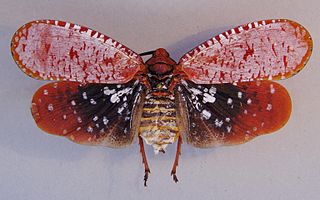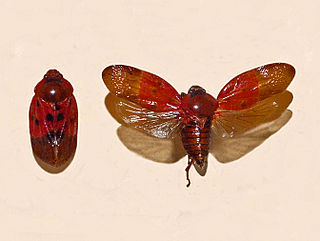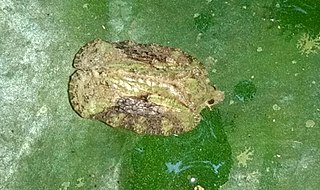
Pentatominae is a subfamily of Pentatomidae, a family of shield bugs. This subfamily is the largest one within the Pentatomidae, having 4937 species classified in 938 genera. Species in this subfamily are phytophages and several of them are considered agricultural pests. Some invasive pentatomines such as Halyomorpha halys and Bagrada hilaris have been considered household pests. Higher systematics of the group have been revised by Rider et al.

Ricaniidae is a family of planthopper insects, containing over 400 species worldwide. The highest diversity is in tropical Africa and Asia and in Australia, with a few species occurring in the Palearctic and Neotropical realms. It is one of the smaller families in the planthopper superfamily Fulgoroidea.

The subfamily Aphaeninae is a group of hemipteran insects, especially abundant and diverse in the tropics, in the family Fulgoridae, or "lanternflies".

Cercopidae are the largest family of Cercopoidea, a xylem-feeding insect group, commonly called froghoppers. They belong to the hemipteran suborder Auchenorrhyncha. A 2023 phylogenetic study of the family suggested the elevation of subfamily Ischnorhininae to full family status as Ischnorhinidae, leaving a monophyletic Cercopinae.

Leptataspis is a genus of Asian froghoppers belonging to the family Cercopidae and tribe Suracartini.

Dysdercus is a widespread genus of true bugs in the family Pyrrhocoridae; a number of species attacking cotton bolls may be called "cotton stainers".

Aphrophora is a genus of spittlebugs in the family Aphrophoridae. There are at least 80 described species in Aphrophora.

Tropiduchinae is a subfamily of tropiduchid planthoppers in the family Tropiduchidae.

Dictyophara is the type genus of planthoppers belonging to the family Dictyopharidae and tribe Dictyopharini, containing five subgenera. The scientific genus name Dictyophara derives from the Greek and can be translated "who wears a net".

Hemisphaerius is a genus of bugs in the family Issidae and tribe Hemisphaeriini. Species resemble the closely related Gergithus: but are differentiated in this genus by the size of the frons and shorter legs.

The Flatinae are a subfamily of planthoppers, erected by Maximilian Spinola in 1839. Genera have been recorded from all continents except Antarctica: especially in tropical and subtropical regions.

Atracis is a genus of flatid planthopper with around 60 species distributed in the Oriental Realm and tropical Africa.

Flatida is a genus of planthoppers in the family Flatidae and tribe Phromniini. Much of the literature on this genus refers to the name Phromnia, which has recently been recognized to be a junior synonym of Flatida. Species from the genus are found in tropical Africa and Asia.

Eoscarta is a genus of froghopper (Cercopidae) with about 50 species distributed in the Oriental region. Species in the genus are identified by a combination of characters that include an elongated pubescent body, highly laterally compressed postclypeus, the hind tibia with a single lateral spur and genital characters of the males.

The Nogodininae are a sub-family of tropical planthoppers erected by Leopold Melichar in 1898. The recorded distribution is: South America, Africa and the Middle East, South and SE Asia through to Australia.















